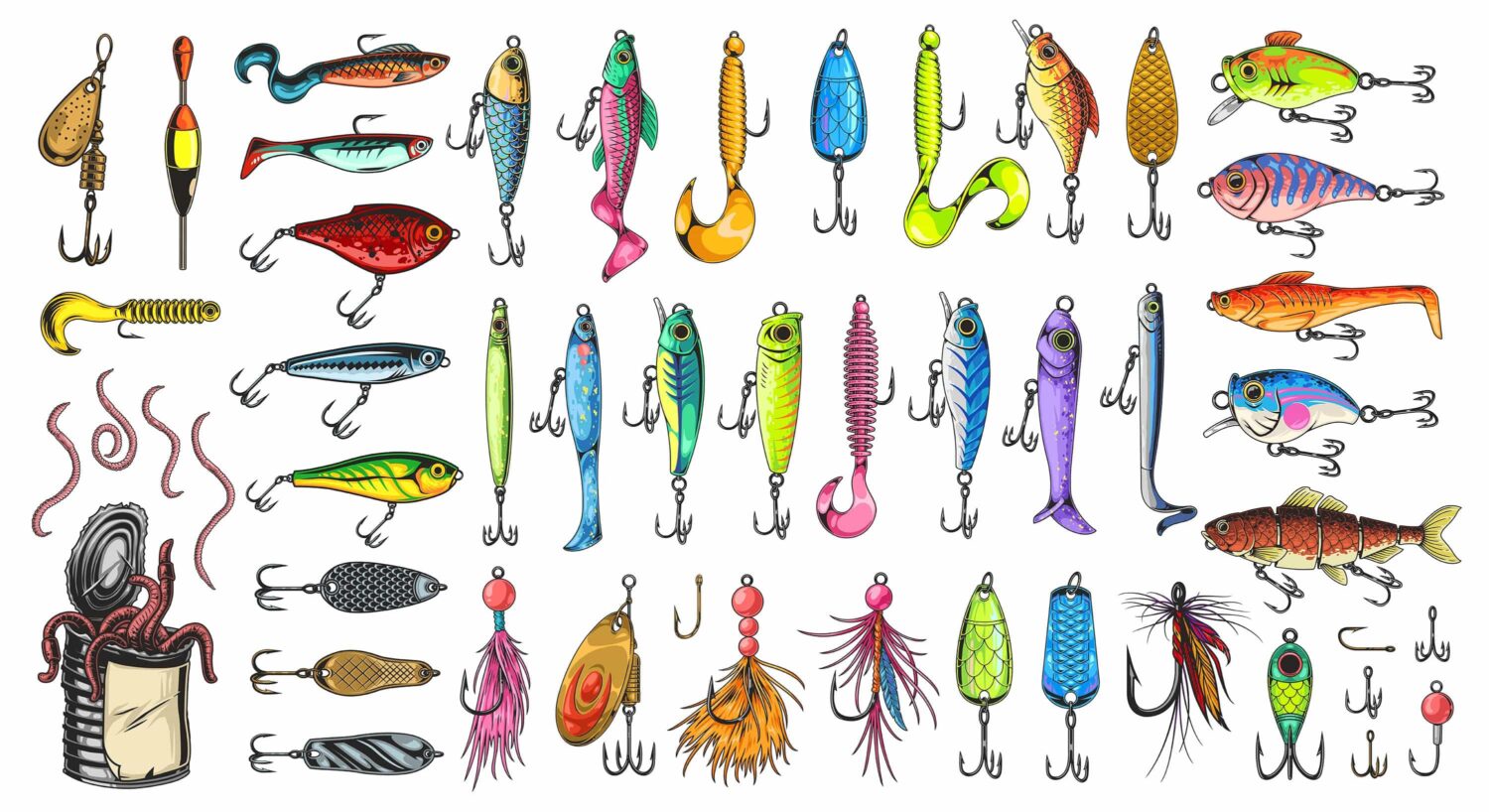If you’ve spent any time chatting with fellow anglers on the dock or in the boat, chances are you’ve heard someone rave about spinner baits. These flashy little lures are one of the most reliable tools in any tackle box, especially when you’re fishing waters like Lake of the Woods where bass and walleye are always biting. But what are spinner baits and why do expert guides and pro fishermen swear by them?
Let’s break it down together so you can reel in the fish of a lifetime.
What are Spinner Baits?
Spinner baits are known for their ability to catch bass, pike, walleye and even trout when conditions are right. The combination of flashing blades and vibrating movement mimics a wounded baitfish, which triggers a predatory response in aggressive fish like bass and walleye—even when they’re not actively feeding.
Known for its distinctive wire-frame design that resembles an open safety pin, a spinner bait is a type of fishing lure. On one end, you’ve got one or more spinning blades—often shaped like teardrops or ovals—that flash and flicker as they move through the water. Also known as a safety pin spinner, the opposite end has a skirted hook that flares out to imitate baitfish like shad or perch.
What are Spinner Baits Used for?
Spinner bait really shines luring in trophy-worthy catches in stained, murky or choppy water. That vibration and flash help grab the attention of aggressive fish who strike on instinct, even when it’s hard to see. At Duck Bay Lodge, spinner baits really shine in the spring and summer months, especially during the spawning and post-spawn periods, when bass, pike and walleye are holding shallow and hitting hard in mid-depth cover.
Whether you're new to casting or have decades of stories to tell, spinner baits are a smart pick for covering a lot of water fast. Here’s a breakdown of species known to go after spinner baits, plus some notes on how and when they’re most effective:
Top Species That Go for Spinner Baits
Largemouth Bass
- Most popular target for spinner baits
- Very responsive to flash and vibration in stained or choppy water
- Ideal during spring and fall when bass are in shallow cover like weeds, timber or docks
Tip: Use chartreuse/white spinner baits with Colorado blades in murky water and willow blades in clear water.
Smallmouth Bass
- Hit spinner baits aggressively, especially in rocky or current-driven areas
- Prefer a faster retrieve and more natural color patterns (shad, silver, white)
- Very effective during pre-spawn and post-spawn periods
Northern Pike
- Highly aggressive predators that love the thump and flash
- Often strike spinner baits in weedy bays and shallow flats
- Use a wire leader to prevent bite-offs due to sharp teeth
Tip: Larger spinner baits with big Colorado blades and bright skirts (firetiger, gold) work great.
Walleye
- Not traditionally associated with spinner baits, but they’ll hit them in shallow, cover-rich areas post-spawn
- Best used around flooded timber, grass or rock during low light or stained water conditions
- Slow rolling along bottom or parallel to structure can produce
Trout (Occasionally)
- More responsive to in-line spinners, but small-profile spinner baits (1/8–1/4 oz) can work for stocked or aggressive trout
- Best in stained or fast-moving streams where flash draws attention
Muskie
- Similar to pike, muskies will smash oversized spinner baits (like tandem bucktail-style lures)
- Common tactic in Lake of the Woods and other northern fisheries
Crappie and Panfish
- Usually prefer smaller baits but will occasionally strike tiny spinner baits or bladed jigs
- Spinnerbaits that mimic small minnows can trigger reaction bites in spring
Why These Fish Go for Spinner Baits
Spinner baits simulate:
- Injured baitfish through flashing blades
- Movement that triggers predatory instincts
- Vibration that fish detect through their lateral line, even in murky water
They’re also snag-resistant and great for covering water quickly, which makes them ideal for locating active fish across species.
How Do Spinner Baits Work
Unlike crankbaits or soft plastics that rely heavily on realistic detail, spinner baits rely on action. As you reel the spinner bait in, the water resistance causes the blades to spin or thump. That constant spinning motion triggers instinctual strikes from hungry fish.
That spinning generates:
- Flash, which mimics the glint of baitfish scales
- Vibration, which fish detect through their lateral lines (especially useful in stained or murky water)
- The skirt on the hook flares and pulses with the motion of the retrieve, further imitating an injured or fleeing baitfish
One of the biggest advantages of spinner baits is their ability to fish through all kinds of cover—grass beds, submerged timber, rocky points, you name it. The design helps prevent snags, so you can toss them where fish like to hide.
And let’s not forget versatility. Whether you’re targeting bass, walleye, pike or even crappie, spinner baits deliver. If you’re headed up for one of our Lake of the Woods fishing trips, don’t be surprised if your guide recommends a spinner bait first thing in the morning—or just after a storm stirs things up. Fish are especially responsive to the flash and vibration in low-light conditions or murky water.
What are Spinner Baits Used for and Why Do Pros Rely on Them?
Many professional fishermen absolutely swear by spinner baits—especially for bass fishing. While the lure may seem old-school to some, top anglers consistently return to spinner baits when conditions call for speed, vibration and structure coverage. Here's what makes pros loyal to this classic:
Consistent Tournament Producer
Many bass tournament pros keep spinner baits on deck because they:
- Cover water quickly, especially during pre-fish scouting
- Trigger reaction bites when fish aren’t actively feeding
- Shine in stained, windy or overcast conditions
Deadly in Specific Conditions
Pros pull out spinner baits when:
- Wind is blowing across points and flats (causes baitfish to scatter)
- Water is stained or murky from recent rain
- Shallow cover like weeds, docks or wood needs to be worked quickly
Trust in Versatility
Pros like Brandon Palaniuk and Kevin VanDam (KVD) have also used spinner baits as go-to lures in:
- Fall transition when baitfish school up
- Cold front conditions when fish suspend near cover
- Heavy vegetation zones where crankbaits would snag
KVD, especially, has promoted spinner baits throughout his career and designed models for Strike King—one of the most trusted spinner bait brands among competitive anglers.
Pro anglers don't just like spinner baits—they rely on them when it counts.
While newer techniques like Chatterbait and swimbaits get a lot of hype; spinner baits still offer a unique combination of:
- Snag resistance
- Multi-sensory attraction
- Speed and control near structure
That’s why seasoned pros don’t leave the dock without at least one tied on—especially when fishing bass-heavy waters like Lake of the Woods.
Best Bass Spinner Baits
With so many spinner baits on the market, which ones actually earn their place in your tackle box?
For bass, our guests often swear by the 3/8 oz. and 1/2 oz. sizes. These weights are perfect for casting long distances and working different depths. Color-wise, chartreuse/white, firetiger and shad patterns are time-tested favorites.
As for blades, each style has its strengths:
- Willow blades are long and slender, creating more flash and less vibration. Ideal in clear water where fish can see well.
- Colorado blades are round and thump hard, which is perfect for stained water and overcast days.
If you're chasing big northern pike or walleye in weedy shallows, try a gold or silver blade paired with a flashy skirt. The combination of vibration and shine works wonders in darker water.
As for brands, you can't go wrong with trusted names like Strike King, War Eagle, Booyah or Terminator. These are the same lures many of expert fishing guides rely on day in and day out.
Looking to switch it up? The best spinner bait for trout often has a smaller profile—think 1/8 oz. or 1/4 oz.—with subtle, natural colors and a single blade. Trout are more likely to strike when the presentation feels delicate and lifelike.
What Are Spinner Baits Good For and How Do you Use them?
Here are a few time-tested tips to make the most of your spinner bait setup:
- Vary Your Retrieve: Mix things up with slow rolling near the bottom, “burning” it across the surface or using a yo-yo technique to bounce it along the water column. Fish often strike on the drop!
- Fish Parallel to Cover: Cast along weed edges, docks and rocky points. Running your spinner bait parallel to structure keeps it in the strike zone longer.
- Use the Right Gear: We recommend a medium-heavy rod with a fast tip, 12–17 lb. fluorocarbon or monofilament line and a reel with a 6.3:1 gear ratio. This combo gives you the power and control needed to fight strong fish through cover.
- Avoid Common Mistakes: Don’t reel too fast in cold water—fish are sluggish and may miss the bait. Also, match your blade style to the water conditions and don’t fall into the trap of using the same speed every cast. Fish like variety!
Catch Spinner Bait Action at Duck Bay Lodge
Lake of the Woods is truly a spinner bait paradise. With stained water, loads of structure and thriving populations of bass, pike and walleye, there’s no better place to try your hand with these lures. Whether you’re casting into lily pads at sunrise or slow rolling past submerged boulders in the afternoon, spinner baits reel in monster fish for lifelong memories made out on the water.
At Duck Bay Lodge, we make it easy to hit the water with confidence. Our expert fishing guides know exactly when and where spinner baits will produce and we’re stocked with proven gear to help you get hooked up.
Whether you're brand new to fishing or just want to try something new on your next trip, spinner baits are a fun way to reel in your personal best. Want to fish some of the best waters in Canada? Learn more about our Lake of the Woods fishing trips, or call today to plan your trip with one of our expert guides.

